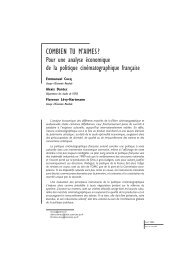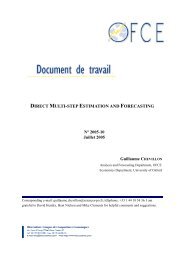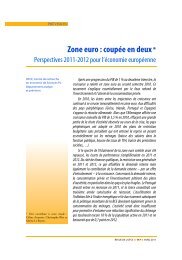N° 2005-09 Juin 2005 Guillaume Daudin* Jean-Luc Gaffard ...
N° 2005-09 Juin 2005 Guillaume Daudin* Jean-Luc Gaffard ...
N° 2005-09 Juin 2005 Guillaume Daudin* Jean-Luc Gaffard ...
You also want an ePaper? Increase the reach of your titles
YUMPU automatically turns print PDFs into web optimized ePapers that Google loves.
<strong>Jean</strong>-<strong>Luc</strong> <strong>Gaffard</strong> and Michel Quérécountries (and at the benefit of the less developed), become harmful when these distortionsend in a lower growth rate and a higher unemployment rate in the former countries. Thisphenomenon has nothing to do with international trade per se, though it reveals how domesticdistortions may change the impact of international trade. In this case, public policies thatfocus on competitiveness of territories may amplify these distortions, which are mistakenlyattributed to international trade.Although there is no evidence that relocation is now a significant problem indeveloped countries, it is nothing but an aspect of the breaking-up in the industrial structures,which is the nature of any innovation process, and of the intrinsic difficulty to manage thisprocess, whatever the degree of trade liberalisation.It feeds a current debate, which has the advantage of signalling the complexity of therelation between the geographical distribution of economic activities and the performances ofcountries. The real problem lies in the distortion that emerges from an inevitable and powerfulstructural change. International trade, which is beneficial in an undistorted economy turns tobe harmful because of a domestic distortion. Thus, harmful effects of international trade mayoccur in developed countries as a consequence of strong productivity gains that wouldcharacterise production by less developed countries of goods for which these countries hadpreviously a comparative disadvantage (Samuelson 2004) This does not mean that distortionsin the international trade (protectionism) must be introduced (Krugman 1996). The logicanswer is that domestic distortions have to be eliminated. Thus, it is necessary to identify thenature and the significance of these domestic distortions. Are they cost differentials, too highwages, or anything else? To what extent are they related to external trade and foreigninvestment?The remainder of this paper contains four sections. Section 2 offers an analysis ofrelocation within the standard (equilibrium) framework, which leads to focus on fundamentalsand ipso facto to recommend competitiveness strategies, the efficiency of which is reallydoubtful. Section 3 then focuses on the real nature of distortions and co-ordination issues atthe local (national) level. Section 4 shows how domestic distortions influence reciprocaldemands, and hence why and how international trade matters. Finally, section 5 reviewspolicy implications.64








